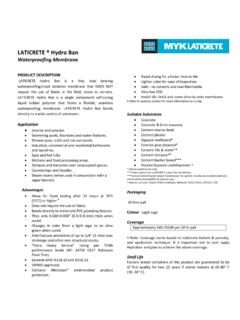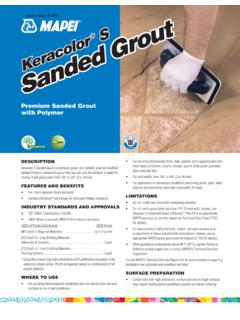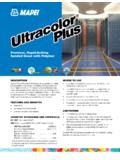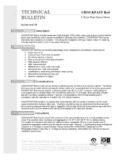Transcription of LATICRETE® 254 Platinum
1 laticrete 254 Platinum Thin-set AdhesivePRODUCT DESCRIPTIONThe ultimate one stop, polymer modified, thin-set mortar for interior and exterior installation of ceramic tile, stone, quarry tile, pavers and brick. laticrete 254 Platinum , designed to mix with water, has a long open time with unsurpassed adhesion and workability. laticrete 254 Platinum is a laticrete approved substitute for laticrete 111 Powder mixed with laticrete 73 for exterior and underwater application, superior bond to exterior glue plywood and concrete. The ultimate thin-set for porcelain and glass Single component, just add water High strength, polymer fortified Easy to use Economical Bonds to various substrates Exceeds ANSI sheer bond strength requirements Complies to EN 12004 as C2 T E S1 Water resistant & Shock resistant Suitable Substrates Concrete Concrete Masonry Cement Mortar Beds Cement Plaster Ceramic Tile and Stone Brick Masonry Cement Backer Board** Cement Terrazzo Exterior Grade Plywood* Gypsum Wallboard* Calcium Silicate board ** Interior use only **Consult the backer board manufacturer s data sheet for the specific recommendations.
2 Packaging 5 kg & 20 kg bagsColour: Grey and whiteCoverageApprox 55-60 sft per 20kg bag with (6mmx6mm) Square notched trowel for a bed of 3 will vary depending on trowel notch size, type and size of tile and substrateShelf LifeFactory sealed containers of this product are guaranteed to be of first quality for one (1)* year if stored off the ground in a dry area. *High humidity will reduce the shelf life of bagged product. Limitations Not for use directly over particle board, luan, Masonite or hardwood floors. Not for use over VAT, VCT cutback, vinyl and plastic laminates. Use LATAPOXY 300 Epoxy Adhesive for installing green marble or water sensitive natural stone and agglomerates.
3 Use white mortar for white or light colored marble/stone. Adhesives/mastics, mortars and grouts for ceramic tile, pavers, brick and stone are not designed as replacements for waterproof membranes. When a waterproofing barrier is requi-ired, use a laticrete 9235 Waterproofing Membrane NOTE: Surfaces must be structurally sound, stable and rigid enough to support ceramic/stone tile, thin brick and similar finishes. Substrate deflection under all live, dead and impact loads, including concentrated loads, must not exceed L/360 for thin bed ceramic tile/brick installations or L/480 for thin bed stone installations where L=span TO THE SPECIFIER AND INSTALLER.
4 While installing tile/stone on the external walls and floors, we need to provide the movement joints by creating spaces between the tiles/stones and filling them up with cement based grout mixed with L1776 grout admix plus or silicone is also important to note that the exterior tile / stone installations are provided with joints (spaces) on the periphery of the area without allowing the tile / stone to be bound by the peripheral masonry work or is also important to note that the tiles/stones are not installed directly on expansion joints. The expansion joints need to be run through the tile / stone work till top surface and filled with materials which accommodate the During cold weather, protect finished work from traffic until fully cured.
5 Contains Portland cement and silica sand. May irritate eyes and skin. Avoid contact with eyes or prolonged contact with skin. In case of contact, flush thoroughly with water. Do not take internally. Silica sand may cause cancer or serious lung problems. Avoid breathing dust. Wear a respirator in dusty areas. Keep out of reach of childrenTECHNICAL DATAA pplicable StandardANSI ; EN 12004, ISO 13007 Performance PropertiesLATICRETE 254 Platinum MethodResultsShear Bond, Porcelain Tile, 28 day cureANSI ; >500 psi ( MPa)Shear Bond, Porcelain Tile, Water ImmersionANSI ; >300 psi ( MPa)Shear Bond, Quarry tile to Plywood,28 day cure ANSI ; >265 psi ( MPa)Compressive Strength at 28 daysANSI.
6 A 118. 4 1999:>2500 psi( Mpa)Compressive Strength 28 DaysANSI ;>2790 psi( MPa)Conforms to EN & ISO standards: C2ET S1 Working Properties 70 F (21 C) laticrete 252 Ag Silver Adhesive mixed with WaterOpen TimeApprox 40 minutesPot LifeApprox 3-4 hoursTime to Heavy TrafficApprox 24 hoursSpecifications subject to change without notification. Results shown are typical but reflect test procedures used. Actual field performance will depend on installation methods and site PreparationAll surfaces should be between 40 F(4 C) and 90 F(32 C) and structurally sound, clean and free of all dirt, oil, grease, loose peeling paint, laitance, concrete sealers or curing or uneven concrete surfaces should be made smooth with laticrete Latex Portland Cement underlayment to provide a wood float (or better) finish.
7 Dry, dusty concrete slabs or masonry should be dampened and excess water swept off. Installation may be made on a damp surface. New concrete slabs shall be damp cured and 28 days old before application. *No minimum cure time for concrete slabs when thin-set mortar is mixed with latex additive. All slabs must be plumb and true to within (6mm) in 10 ft(3m). Expansion joints shall be provided through the tile work from all construction or expansion joints in the substrate. Follow ANSI Specification ANSI Requirements for Expansion Joints or TCA Detail EJ171 Expansion Joints . Do not cover expansion joints with mortar.
8 Cement Backer Board: follow TCA installation detail Installer must verify that deflection under all live, dead and impact loads of interior plywood floors does not exceed industry standards of L/360 for ceramic tile and brick or L/480 for stone installations where L=span length;2. Minimum construction for interior plywood floors:SUBFLOOR: 5/8 (15mm) thick exterior grade plywood, either plain with all sheet edges blocked or tongue and groove, over bridged joints spaced 16 (400 mm) maximum; fasten plywood 6 (150mm) along sheet ends and 8 (200mm) along intermediate supports with 8d ring-shank, coated or hot dip galvanized nails (or screws); allow 1/8 (3mm) between sheet ends and (6mm) between sheets edges; all sheet ends must be supported by a framing member; glue sheets to joints with construction adhesive.
9 UNDERLAYMENT: 5/8 (15mm) thick exterior grade plywood fastened 6 (150mm) along sheet ends and 8 (200mm) in the panel field (both directions) with 8d ring-shank, coated or hot dip galvanized nails (or screws); allow 1/8 (3mm) to (6mm) between sheets and (6mm) between sheet edges and any abutting surfaces; offset underlayment joints from joints in subfloor and stagger joints between sheet ends; glue underlayment to subfloor with construction adhesive. Refer to Technical Data Sheet 152 Requirements for Direct Bonding of Ceramic or Stone Tiles Over Wood Floors for complete Stir laticrete Admixture thoroughly before clean, potable water or laticrete latex admix into a clean pail.
10 Add laticrete 252 powder. Use approximately 6L of water for 20 kg of by hand or with a slow speed mixer to a smooth, trowelable consistency. Allow adhesive to slake for 5-10 minutes. Adjust consistency if necessary. Remix and apply with the proper sized notched ) Ceramic Tile/StoneApply adhesive to the substrate with the flat side of the trowel, pressing firmly to work into surface. Comb on additional adhesive with the notched side. Use the proper sized notched trowel to insure full bedding of the tile. Spread as much adhesive as can be covered with tile in 10 minutes. Back butter large tiles (> 12 x12 ) to provide full bedding and firm support.







